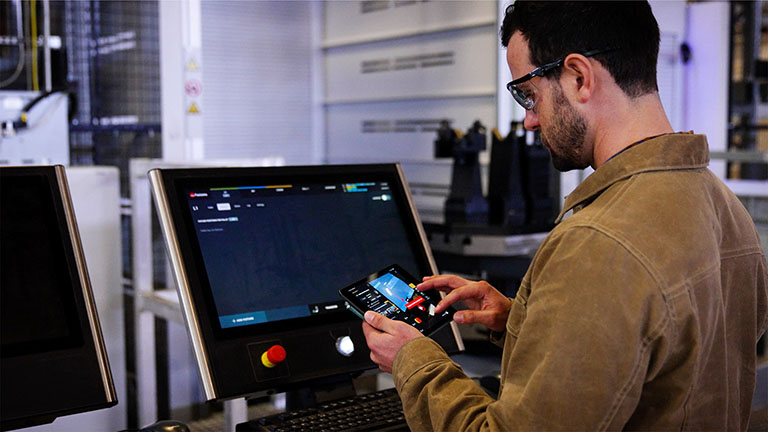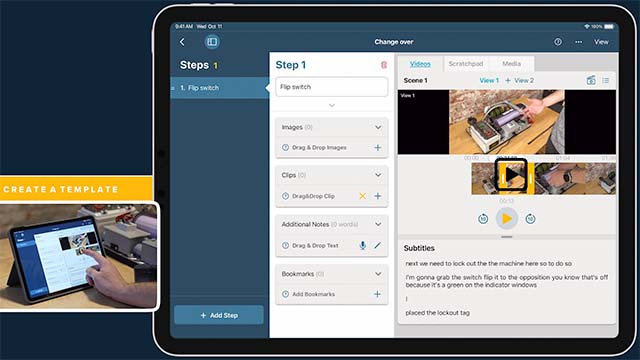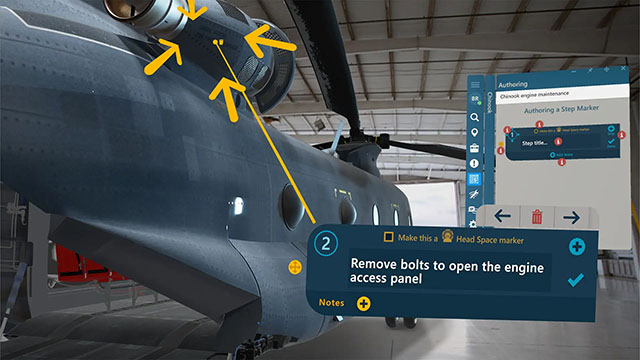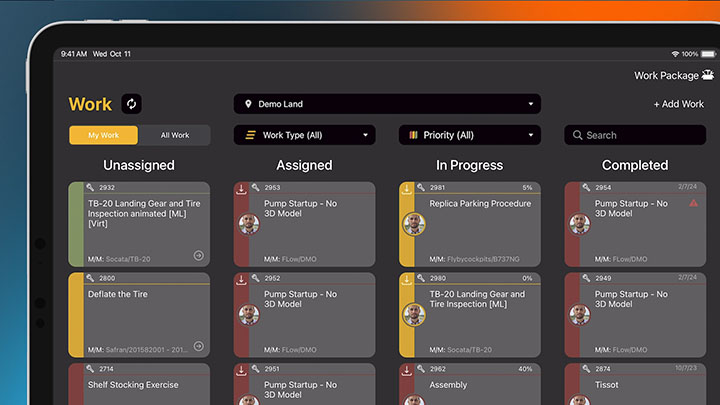Manifest version 2.8 includes a variety of updates and enhancements. Some of these updates also introduce changes to prior releases with respect to the Manifest UI and Fault Management system. Please read below to learn more about the upcoming changes and timing.
Release Notes
| Application | Release Notes |
| Manifest Web Application 2.8 | Manifest Web Application | 2.8 Release Notes |
| Manifest 3D 2.8 | Manifest 3D for HoloLens | 2.8 Release Notes |
| Manifest iPadOS 2.8 | Manifest iPadOS | 2.8 Release Notes |
| Manifest for Docker 2.8 | Manifest for Docker | 2.8 Release Notes |
New Features & UI Changes in Manifest 2.8
New Job UI on Web
The Manifest Web Application has an updated Job UI, new and improved – maximizing the full screen view, automatically loading Step Notes in a larger display that can easily be swiped or tapped through, and clear call to action buttons for marking a Step complete or adding evidence.
Fault management has a major upgrade!
The new Fault system has been developed so that Faults can be added, tracked, and managed independently from Jobs and procedures. So, several UI changes have been implemented to support this new capability.
- UI changes are as follows:
- New UI to Fully document and describe a Fault when flagging it has been added by providing a Fault description, and Fault Notes which could include 3D Pen Notes, text, photos, videos and audio recordings.
- A new work item, Task, has been introduced that can be used to create and assign non-procedural work items and can be associated with a specific Fault.
- A new organizational element, Work, has also been introduced and generally refers to both Jobs (Manifest procedural Templates associated with specific Assets and Locations) and Tasks (new non-procedural work items that can be assigned and track independently).
- Changes to enabling spatially place Faults over the Asset or environment (3D and iPad only) so that workers can easily locate equipment with Faults and the specific locations of faults, as well as all the associated data.
- UI now supports adding a Fault during a Job from a specific Job Step (Job ID and Step will be recorded on the Fault), or directly from the Asset.
- UI to support adding a Job or Task to a Fault to require additional work and then keep track of the Open Work Items for Faults.
- Easily and quickly view the Faults for any Asset. Find the desired Asset and from the Asset Details, view a list of any Faults (Open and Resolved). If working on the 3D application, users can view AR Fault Markers directly over the Asset along with any leader lines pointing to the issue, or 3D Pen Notes. This also includes a historical record of Faults associated with a specific Asset.
- View Fault meta data, from a listing or AR Marker, in both Web and 3D. Fault data includes the date/time the Fault was added, who created the Fault, the Job + Step the Fault was added from (if applicable), a Fault description, and any associated Notes or Work.
- Resolve Faults after issues have been addressed. When The Fault is marked as “Resolved”, the date/time and user who resolved the Fault are both recorded.
Additional features and updates
Configure Fault Notes
- Administrators can define what note types should be available and/or required when a user creates a Fault.
- i.e.: if an Admin determines that Fault Note options should include only Photo and Pen, this can be configured for the domain. If the Admin would like to always require a Photo Note, this note can be marked ‘required’. This all happens in the new Faults page and will be applied for all cases where a Fault is added, on any platform
View Fault Reporting on the Web Application
- A new Fault page will display a list of all Faults in the Manifest domain, along with associated Notes and Work. This provides a single view directly from the users’ desktop to view all Faults across any Location and for all Assets in a domain.
- Asset listings in the Web will now also include a tab to view any associated Faults
Create a Job or a Task
- From the Web application’s Work page, users can add either a Job or a Task. Creating a Task requires only a Description and Location.
- *Note: 3D only supports adding a Task from a Fault and is automatically associated to that Fault and Asset.
View, Assign, Share, Complete a Task
- Tasks display a simple description and ‘done’ button to complete. They can be self-assigned or assigned to another user. There is also a Share button to Share via Connect Chat.
It’s not just Jobs anymore, it’s “Work”
- With the addition of Tasks, we now have 2 work types users can utilize to create and track their work. As a result, you’ll find that menus and various labels throughout the applications have been changed from Jobs TO Work.
Filter in new ways to organize your Work
- On 3D, we’ve updated the filters in both the Dashboard and Work windows to now include Tasks. We’ve also added the option for users to filter any Work windows to show only “My Work” by the tap of a new toggle button.
- (e.g. Dashboard- My Work, Work, Asset Work and Work History lists)
View Fault Flags on the Asset Listing
- Whether an Asset is on your Favorited list or in your Dashboard Recent Activity, Search Results, or viewed as a list of Assets at a Location, the Fault flag will display on the Asset Listing – signaling with a quick glance if there’s an issue.
Updating to the new Fault Management System
With the new Fault Management system released with Manifest version 2.8, it’s important to be aware that ‘old’ and ‘new’ Faults will not have cross-version support. Faults recorded with Manifest versions prior to 2.8 will not be viewable with Manifest 2.8 (and beyond). Similarly, Faults added on 2.8 will not be available on previous versions.
Support questions
Will I be forced to update to the ‘new’ Fault Management system?
- The Web application has automatically updated to version 2.8 and only supports viewing and creating Faults based on the updated system. Application and Docker 2.8 releases will be optional updates.
Which applications will still be using the ‘old’ Fault Management system?
- The following versions will remain on the old Fault system:
- Manifest 3D versions between 2.3 – 2.7.4
- Manifest iPadOS versions between 2.3 – 2.5.3
- Manifest for Docker versions up to up to 2.7
- *Note: The Manifest Web Application will not support the old Fault system after July 2023
- *Note: Any client operating on these versions will not be able to view faults created on the new 2.8 system.
- *Note: If clients do not wish to update to the new Fault feature release yet, they would be able to continue adding and viewing ‘old fault data’ if they are operating on any of the above releases. The Manifest Web Application v2.8 will not display old Fault data.
Will we be able to migrate our ‘old’ Fault data to the new Fault Management System?
- Upon request, the Manifest Support team will work with any client who may wish to migrate and maintain old Fault data recorded prior to updating to Manifest 2.8. Please reach out to Manifest Support to discuss this option.
What if some users in the same domain are operating on different versions, or using platforms that do not yet support 2.8 with this staggered release schedule?
- If users are not all operating on the same version, or using a platform that does not yet support the new 2.8 Fault Management system and Task creation, there will be limitations and inconsistencies between what they share and see for these features. Ideally, any client currently using Faults and/or Tasks should ensure all users are operating on the same version.
If we are using an On-Premise (Manifest for Docker) server, how should we coordinate this update?
- Clients using On-Premise (Manifest for Docker) servers should not update Manifest 3D or Manifest iPadOS applications to version 2.8 until their Docker instance is updated to a compatible version for 2.8.
What are the major changes to the Manifest Web Application, with the update to 2.8?
- The following changes will are included in the Manifest Web Application v 2.8:
- The Job UI will be updated
- The Jobs page will be renamed Work
- The new Work page will now include the additional option of creating “Tasks”
- Work and Work History pages now include both Jobs and Tasks
- The ‘Type’ column includes an icon to differentiate between the two Work Types
- Asset Detail will now include a new tab for Faults that includes ‘new’ Fault data
- Asset Detail has changed the labels of Jobs and Job History to Work and Work History
- The Fault Report includes only ‘new’ Fault data
- The Fault Note configuration is only supported on Manifest version 2.8
What is the difference between Tasks and Jobs?
- Tasks are non-procedural work items that can be associated with a specific Fault and assigned to team members to resolve. These also can be “stand-alone” and not be associated with a Fault. Either way, they can be assigned and tracked independently of a Job.
- Jobs are Manifest procedural Templates associated with specific Assets and Locations that are traditionally assigned to a worker and executed.
What is Work?
- Work, is a new organizational UI element that refers to both Jobs and Tasks
Will the new fault system work offline?
- Operators will be able to add Faults to Job Step when performing a Job in Offline Mode, but the ability to view any previously created Faults or add new Faults to the Asset will be disabled. Additionally, it will not be possible to view or add Work to a Fault while working offline.




